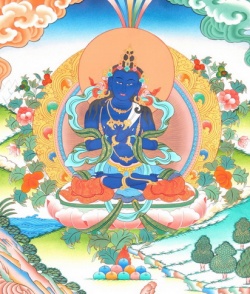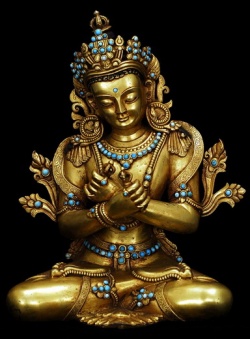Vajradhara (Adi-Buddha)
(Thunderbolt-bearer).
(T.) rdo-rje-hc'an (He who holds a thunderbolt).
(M.) Ocirdara (corruption of Vajradhara), or Vacir bariqci (He who holds a thunderbolt).
Symbols: vajra (thunderbolt), ghanta (bell).
Mudra: vajra-hum-kara.10
Colour: blue.
Sakti: Prajnaparamita.
Other names: Karmavajra, Dharmavajra.
Vajradhara is the supreme, primordial Buddha without beginning or end, lord of all mysteries, master of all secrets. It is to him the subdued and conquered evil spirits swear allegiance and vow that they will no longer prevent or hinder the propagation of the Buddhist faith. He is thought to be too ' great a god and [Page 4] too much lost in divine
quietude to favour man's undertakings and works with his assistance, and that he acts through the god Vajrasattva, and would be to him in the relation of a Dhyani-Buddha to his human Buddha .11
Vajradhara is looked upon as Adi-Buddha by the two greatest sects of the Mahayana school: the dKar-hGya-pa (Red Bonnets) and the dGe-lugs-pa (Yellow Bonnets). 12
He is always represented seated, with his legs locked and the soles of his feet apparent, and wears the Bodhisattva crown as well as the dress and ornaments of an Indian prince. He has the urna and ushnisha. 13 His arms are
crossed on his breast in the vajra-hum-kdra mudra holding the vajra and ghanta. These two symbols may, however, be supported by flowering branches on either side, the stems being held in the crossed hands, which is his special mystic gesture (v. PI. n, fig. b, and PI. in, fig. c).
As 'Karmavajra' (Dorje las) his left hand holds a lotus and his right hand is in vitarka (argument) mudra: arm bent, hand raised, palm turned outward, all fingers extended upward except the index and thumb which touch at the tips, called 'triangular pose' (v. vitarka).
As 'Dharmavajra' (Dorje c'os) his right hand balances a double vajra at his breast, and the left holds the bell on the hip.
When Vajradhara holds his sakti in yab-yum 14 attitude, his arms are crossed at her back, holding his usual symbols. The yum holds a vajra and kapala (skull-cup).

